
Spanish Film Resources
Land FillHarmonic
Coming Spring 2020
Lupe Bajo el Sol
Lupe is an aging migrant worker who spent his entire life working in the California fields. He wants to return to Mexico before it is too late.
“The atmospherics of semi-abandoned border locations are often hauntingly evoked as no-man’s lands, appropriately inhabited by immigrants who are, like Lupe, dangerously close to being no-men.”
The Hollywood Reporter, June 16, 2016
Questions to consider before watching:
Do you think that family is a very important part of our lives? Do you value your traditions and customs? Is it important to look at our past, where we come from in order for us to project our future?
How do you think being separated affects immigrants and their families? If you were separated from your family, what impact would be in your life?
Questions to consider during the movie:
At the beginning of the film, silence is Lupe’s only companion. Why do you think the director chose to introduce the film that way?
What kinds of feelings does this silence transmit to the audience: solitude, sadness, isolation… a sense of being overwhelmed?
What themes does the movie explore? What contradictions do we see in the characters? Is Lupe’s personality well or poorly represented?
Lupe’s grandson narrates the beginning and the end of the film. What does she say about Lupe moving to the United States in these two parts? (the secret)
Questions to consider after the movie:
Lupe doesn’t show and share his emotions and suffering. How do you describe his personality? Insensitive, selfish, overwhelmed, practical, self-denying, stoic?
The doctor gave Lupe a diagnostic about his symptoms “high blood pressure.” Is Lupe honest with the doctor? Why do you think Lupe rejects following his treatment?
Learn more about refugee and migration issues:
“They come to a huge city and are completely disconnected from the community they were familiar with. Some never settle.”
Caroline O’Connell, The Irish Times, ‘Loneliness and isolation are feelings every emigrant can identify with‘, May 7, 2015
Icebox
Oscar, a 12-year-od Honduran boy, is forced to flee his home. He seeks to be free, but is caught in the immigration system. This film was a featured part of Romance Languages Week 2019, presented by the Department of Romance Languages and Literatures in collaboration with the Institute for Social Concerns.
Migrants are vulnerable, feeling alone and isolated. The recognition of this fact is vitally important if we wish to give a concrete and dignified response to this humanitarian challenge. The issue of migration is not simply one of numbers, but of persons, each with his or her own history, culture, feelings, and aspirations. These persons, our brothers and sisters, need “ongoing protection”, independently of whatever migrant status they may have. Their fundamental rights and their dignity need to be protected and defended. Particular concern must be shown for migrant children and their families, those who are victims of human trafficking rings, and those displaced due to conflicts, natural disasters and persecution. All of them hope that we will have the courage to tear down the wall of “comfortable and silent complicity” that worsens their helplessness; they are waiting for us to show them concern, compassion, and devotion.
Pope Francis’ teaching on migration and separation of children from their families, June 14, 2018
Questions to consider before you watch the film:
The United States is a country of immigrants. Do you know where your ancestors came from? If they are not Native American, why did they come to this country from elsewhere? Do you know their stories?
Nowadays, the largest wave of immigration to the United states comes from Latin America. For what reasons do people from this region immigrate to this country? What problems do they face in their countries of origin that prompt them to begin a new life here, with or without legal status?
Questions to consider when you watch the film:
At the beginning of them film, the mara kidnaps and marks Oscar, forcing him to be a member of the gang. What happens later in the school? Why do Oscar’s parents make him leave for the United States that night?
What are the relationships like between Oscar and his family? Who will he live with in the United States?
During the trip to the border, in the middle of the night, men stop the truck in search of young girls. Why?
At the next stop, the group has to wait until night to cross the fence and ride bikes through the desert. Oscar’s tire is punctured, and he’s not abel to follow the group. The Coyote asks Oscar to come back and work for him. When a man in the group wants to fix Oscar’s bike, the Coyote won’t let him. Why does Oscar run away from the group in the middle of the desert? Why is he afraid?
While the American authorities are holding Oscar, what is his life like?
When journalists visit the place where children are detained, what do they speak with the children about? What information are they going to publish?
Finally, Oscar meets his uncle Manuel. Why is Manuel always afraid?
Oscar has an interview with the judge. What decision does the judge make?
Oscar dreams of going to school but cannot. What does he do at the end of the movie?
U.S. Catholic Bishops’ Statements on Migration
Strangers No Longer: Together on the Journey of Hope
Welcoming the Stranger Among Us: Unity in Diversity
Learn more about refugees and migration issues and services using these resources:
United States Conference of Catholic Bishops department of Migration and Refugee Services (MRS) is the largest refugee resettlement agency in the world, and is one of two agencies authorized by the U.S. Department of State to resettle unaccompanied refugee children. MRS serves as a leader in the protection of unaccompanied, refugee, and immigrant children by providing family reunification and foster care services. Check out multiple resources at this site.
Bridging Refugee Youth and Children’s Services is the national technical assistance program working to broaden the scope of information and collaboration among service providers in order to strengthen services to refugee children, youth, and their families.
National Immigrant Justice Center: A Heartland Alliance Program
Additional resources can be found on the Icebox film website
Get Involved:
Contact: Humberto Delgado, (574) 233-2120, beto@lacasadeamistad.org
Student Coalition for Immigration Advocacy
Contact: Joe Miller, (574) 288-6645, jmiller@stadalbertschool.org
South Bend Community School Corporation – Bilingual Services Department
Contact: Julia Cordova-Gurule, (269) 687-2885, jcordovagurule@sbcsc.k12.in.us
Contact: Cameron Dixon, (574) 232-0220, carmen@elcampito.org
Naturalization Ceremony at Notre Dame
April 5, 2019 | Washington Hall
Rumble: The Indians who Rocked the World
We offer this list of resources for those who wish to continue learning about issues impacting Native American communities and become involved.
The Institute for Social Concerns is pleased to be a partner in presenting this film, and invites you to consider the following quotes and questions as you view this film and participate in discussion.
“No society can live in peace with itself, or with the world, without a full awareness of the worth and dignity of every human person, and of the sacredness of all human life.”
— “Living the Challenge of Peace: God’s Call and our Response”, USCCB, 1983, paragraph 285
Questions to consider while viewing the film
Why would music by Native people have been perceived as posing a threat? Why would one have been jailed, penalized, and even murdered (Wounded Knee) for singing traditional songs or performing traditional dances?
Why is it important for Native Americans to claim / reclaim their music traditions within American music history? How did folk music give Native Americans a voice?
Describe the mingling of Native American and African American cultures. Why did Native Americans hide in African American communities? What advantages did it provide?
Describe the message Jimi Hendrix intended through his interpretation of “The Star-spangled Banner.” Why did Jimi Hendrix advise Redbone to “do the Indian thing”? How did Stevie Salas turn “not fitting in” into an advantage in his early career? How did he create an identity?
How does guilt about the past move us to oppress others? Describe how the “medicine of the arts” played a role at Standing Rock.
Resources for getting involved and learning more
American Indian Catholic Schools Network — includes a summer internship program
Pokagon Band of Potawatomi — comprehensive resources and information
Center for the Study of Languages & Cultures — tutoring available in Cherokee; other Native languages resources coming soon
Institute for Social Concerns‘ Summer Service Learning Program — placements available in Native American communities for summer 2019
Native American Initiatives at Notre Dame
Native American Student Association of Notre Dame (find on Facebook)
Native American Law Student Association
Department of Film, Television and Theatre
Department of Romance Languages and Literatures
Kellogg Institute for International Studies
Office of Multicultural Student Programs and Services
Fall 2018 course
AMST 30137: Prof. Brian Collier
“History of Indigenous Education in America”
Postgraduate service opportunities with Native communities
Contact Sarah Greenawalt for information.
Jesuit Volunteer Corps Northwest – placements in legal clinics, environmental and public agencies, community health centers, schools, and social service agencies
Mercy Volunteer Corps – volunteers work with moderate to severely disabled Navajo children and adults
Red Cloud Volunteer Program – volunteers serve nearly 600 Lakota students in one of three Catholic, Jesuit schools on the Pine Ridge Indian Reservation in South Dakota.
Saint Francis School – serves the Jicarilla Apache Nation in Dulce, New Mexico, and the people of Lumberton, a rural ranching community.
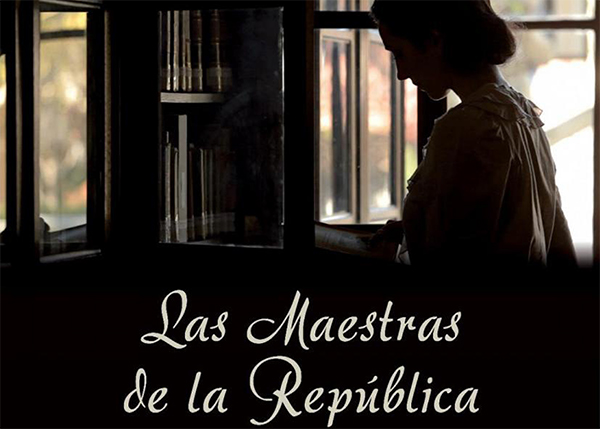
Las Maestras de la República
“I knew that I could fill my life with only my school. I said to myself, there cannot exist a dedication more beautiful than this; to share with children all that I knew, to awaken in them the desire to find out, for themselves, the causes of phenomena, the reasons for historical facts. I wanted to educate for La Convivencia (“The Coexistence”), educate in order to acquire knowledge of justice, educate on equality so that not a single talent is lost for lack of opportunities.”
“Education was one of the pillars of the Second Republic. Male and female teachers worked for one public education, joint, secular, and united.”
The Challenge of Peace USCCB 1983
“The obligation for all of humanity to work toward universal respect for human rights and human dignity is a fundamental imperative of the social, economic, and political order.” (66)
“The truth that the globe is inhabited by a single family in which all have the same basic needs and all have a right to the goods of the earth is a fundamental principle of Catholic teaching which we believe to be of increasing importance today. In an interdependent world all need to affirm their common nature and destiny; such a perspective should inform our policy vision and negotiating posture in pursuit of peace today.” (202)
Declaration on Christian Education, Second Vatican Council 1965
“For a true education aims at the formation of all human persons in the pursuit of their ultimate end and of the good of the societies of which they, as members, and in whose obligations, as an adults, they will share.” (5)
Questions to consider
- How do the goals of public education described in the film overlap with the purposes of education described by the Second Vatican Council?
- How is education political? How does education promote peace? Where do we see these in the film? Where in your experiences have you witnessed this?
- Given the complexity of determining outcomes of education reform in long term, as demonstrated in the film and in the commentary offered by the panel, how might we responsibly consider contemporary calls for educational reform?
Resources for Further Study
The Second Republic and the Civil War
Women of the Second Republic (Spain 1931–39)
Cómo fue la Segunda República Española (video)
La lengua de las mariposas (film)
A shy young boy is brought out of his cocoon by a wise teacher who shows him the wonder of the natural world around him, amidst the growing tensions and chaos of the Spanish Civil War. Available at Hesburgh Library Lower Desk (D 02188 FGN )
Get Involved
South Bend Community Partners
La Casa de Amistad (574) 233-2120, Sam Centellas sam@lacasadeamistad.org
El Campito (574) 232-0220, Laura Jensen laura@elcampito.org
Notre Dame Center for Arts and Culture (574) 631-3249, Email: ndcac@nd.edu
Holy Cross Grade School
Two-way Spanish Language Immersion Program
(713) 306-7345 Clare Roach croach1@nd.edu
Robinson Community Learning Center
(574) 631-8759 Email: rclc@nd.edu
For more information about community partners, please see the Community Partners Directory.
Spanish Community-Based Learning (CBL)
Spring offerings : LLRO 13186-02, ROSP 20810-01, 20810-02, 30051-01
Institute for Educational Initiatives (IEI)
Youth Empowerment, Literacy, and Changing Urban Landscapes
ESS 43203: Youth Empowerment, Literacy, Urban Schools
Social Concerns Seminar: L’Arche Community
ESS 33362: Soc Con Sem: L’Arche Community Social Concerns Seminar: Take Ten
ESS 23250: Soc. Con. Sem: Take Ten
Summer Service Learning Program
El Centrito Family Learning Centers
Swope Summer Academic Camp-Upper Room
For other related programs, please visit the SSLP Site Directory
International Summer Service Learning Program
International Summer Service Learning Program
Toledo, Spain Study Abroad
Service Learning (Memory and History: The importance of people in reconstructing the past.)
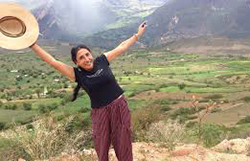
Yo Soy Andina II
Democracy and Human Development in the Andes
In 1967 Pope Paul VI issued the Encyclical, Populorum Progressio, commenting on the development of people. Twenty years later, in 1987, Pope John Paul II issued Sollicitudo Rei Socialis commenting “On Social Concern” as it had been enacted. The Conference of Latin American Bishops issued statements on democracy and development during their General Conference in 2007. As you watch, please note moments in the film where quotes from these various documents on Church teaching are relevant to an understanding of the role of democracy and the importance of human development in the Andes.
We want to be clearly understood: the present situation must be faced with courage and the injustices linked with it must be fought against and overcome. Development demands bold transformations, innovations that go deep. Urgent reforms should be undertaken without delay. It is for each one to take his share in them with generosity, particularly those whose education, position and opportunities afford them wide scope for action. (PP32)
It is painful to think of the numerous young people who come to more advanced countries to receive the science, the competence, and the culture which will make them more qualified to serve their homeland, and who certainly acquire there a formation of high quality, but who too often lose the esteem for the spiritual values which often were to be found, as a precious patrimony, in the civilizations where they had grown up. (PP68)
Open the paths which lead to mutual assistance among peoples, to a deepening of human knowledge, to an enlargement of heart, to a more brotherly way of living with a truly universal human society. (PP85)
It is also right to acknowledge the generous commitment of statesmen, politicians, economists, trade unionists, people of science and international officials – many of them inspired by religious faith – who at no small personal sacrifice try to resolve the world’s ills and who give of themselves in every way so as to ensure that an ever increasing number of people may enjoy the benefits of peace and a quality of life worthy of the name. (SRS 26)
“Participatory democracy is growing stronger with the more assertive presence of civil society, and the emergence of new social actors, such as indigenous people, Afro-Americans, women, professionals, a broad middle class, and organized poor people, and more room for political participation is being created. These groups are becoming aware of the power they hold in their hands and of the possibility of bringing about major changes for achieving more just government policies, which will reverse their situation of exclusion.” Concluding Document Aparecida, V General Conference of the Bishops of Latin America and the Caribbean (Aparecida, 13-21 May 2007) section, 75.
Discuss your responses to these questions after viewing the film:
Living in two cultures offers the opportunity to experiment with new perspectives, and ways of life. In your opinion, what experiences enrich the main character, Nélida, during the years that she lived as an immigrant in New York? In what ways were these different than the opportunities she would have had if she had stayed in her hometown?
After 20 years of living in New York, Nélida decided to return to her country of origin. There she is captivated by the possibilities of making some improvements in her hometown, and even helping her own people. In what ways do we see the acceptance and the rejection of her efforts by the different social groups in this community?
The idea of democracy is that people participate in the decision-making that affects their communities. What differences did you see in the film between the democracy in the United States and the democracy in the film “Soy Andina II the Return”? What challenges to participation are highlighted in the film?
Today many parts of the world are led by men, although there is significant change happening: women are gaining leadership in many traditionally male sectors such as politics, business …etc. In your opinion, do women have the same opportunities as men in the movie? What challenges do Nélida and women in general face in the film? How might the community be different if there were more participation by women and others who may be excluded from leadership?
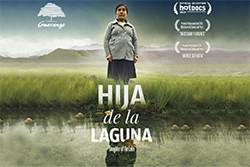
La Hija de la Laguna
And among man’s personal rights we must include his right to enter a country in which he hopes to be able to provide more fittingly for himself and his dependents. It is therefore the duty of State officials to accept such immigrants and—so far as the good of their own community, rightly understood, permits—to further the aims of those who may wish to become members of a new society. —Pacem in Terris, 106
Center for the Study of Languages and Culture (CSLC) The CSLC is a sponsor and volunteer recruiter for the St. Joseph Chapter of the American Red Cross Community Language Bank project. The Community Language Bank provides assimilation programs and foreign language translation and interpretation services to refugees in the South Bend area. stjoe-redcross.org/refugee-services
Courses
CRN 26174 Social Concerns Seminar—Border Issues
CRN 25458 Social Concerns Seminar—Migrant Experience
CRN 2238 International Migration: Mexico/US II
CRN 25069 Immigrant Families and Mental Health
CRN 25457 ROSP 40876 Race and Ethnicity in the U.S.
CRN 29312 ROSP 20810 CBL: Language, Culture and Community
CRN 25012 ROFR 37500: Contemporary Issues w/ Catherine Perry
Also look for Summer Service Learning Program sites serving immigrant communities in the U.S.
Community Alliance to Serve Hispanics (CASH)
CASH serves as a liason between Notre Dame, Saint Mary’s, and Holy Cross students, faculty and staff volunteers, and social service organizations in the South Bend Hispanic community. cash@nd.edu | nd.edu/~cash
Human Rights Notre Dame
Promote the Universal Declaration of Human Rights peace@nd.edu | nd.edu/~peace
South Bend Community Partners
Catholic Charities | Contact: Claire Coleman (574) 234-3111
La Casa De Amistad | Contact: Rebecca Ruvalcaba (574) 233-2120
SBCSC Bilingual Service Department | wbarna@sbcsc.k12.in.us | Contact: Bill Barna (574) 283-8149
St. Adalbert Parish | Contact: Andrew Currier (574) 288-6645
St. Joseph County Chapter, American Red Cross Refugee Services Department | Contact: Anton Murra
Websites for more information
United States Conference of Catholic Bishops on Immigration
Advocacy Center: Justice for Immigrants
U.S. Department of State: Office to Monitor and Combat Trafficking in Persons
Council of Europe Migration Coordination Bureau
United Nations Bureau of International Migration
International Organization for Migration
Questions to consider as you view the film:
What are the three stories?
How do they compare / contrast? (What do we see, hear, learn?)
How does Pacem in Terris help us frame our viewing of the film? (How do we analyze what we learn?)
What is our response to the “the immigration issue,” especially given the election season we are in? (What do we do?)
For a PDF version of this film’s resources, please email Rachel Parroquin.
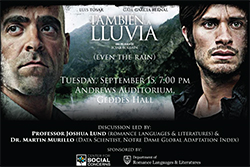
También la Lluvia
Care of All Creation is the Institute for Social Concerns theme for the 2015-16 academic year. Selected in response to Pope Francis’ Encyclical, Laudato Sí: On Care for Our Common Home promulgated in the summer of 2015. Events planned for this year will examine the call to action that Pope Francis makes to “become painfully aware, to dare to turn what is happening in the world into our own personal suffering and thus discover what each of us can do about it.” Laudato Sí, #19
Learn more about the Cochabamba Water Revolt
“Bolivia – Leasing the Rain,” Frontline. June 2002
“Bechtel vs Bolivia: Details of the Case and the Campaign,” The Democracy Center
“Looking Back at the Cochabamba Water Revolt” he Democracy Center. April 2005
Aguas del Tunari, S.A. v. Republic of Bolivia, ICSID Case No. ARB/02/3, italaw.com
Get Involved
Questions to consider as you view the film:
Explain the film title, where does it come from in the dialogue?
Describe scenes that portray privilege in contrast to marginalization. Distinguish between the portrayal of the missionaries and the conquerors in the film.
Describe various moments of resistance and activism on the part of the indigenous people. Do you know of any contemporary movements that empower individuals to resist exploitation?
Describe moments where ‘casual’ exploitation is portrayed in the contemporary scenes of the film. Note the scenes where the characters become cognizant of their insensitivity.
For a PDF version of this film’s resources, please email Rachel Parroquin.

Crude
Solutions must be sought on the global level by establishing a true economy of communion and sharing of goods, in both the national and international order. This is the only way to respect the dignity of persons and families, as well as the authentic cultural patrimony of peoples.—Evangelium Vitae , #91, Pope John Paul II, 1995
In the economic and social realms, too, the dignity and complete vocation of the human person and the welfare of society as a whole are to be respected and promoted. Humans (Man) are the source, the center and the purpose of all economic and social life.—Gaudium et Spes, #63
What kind of economic development may be appropriate when two different groups of people’s needs and rights are in conflict? How do we make ethical decisions in development that benefit national and international goals
while respecting the rights, traditions, and environment of the local community?
“Painting is a form of prayer … it is at once an almost physical experience, and at the same time, the highest transcendent consequence of love and solitude.”
“Pintar es una forma de oración … Es casi una actitud fisiológica y la más alta consecuencia de amor y de la soledad.”—Oswaldo Guayasamín
Furthermore, when man gives himself to the various disciplines of philosophy, history and of mathematical and natural science, and when he cultivates the arts, he can do very much to elevate the human family to a more sublime understanding of truth, goodness, and beauty, and to the formation of considered opinions which have universal value. Thus mankind may be more clearly enlightened by that marvelous Wisdom which was with God from all eternity, composing all things with him, rejoicing in the earth, delighting in the sons of men.—Gaudium et Spes, #57
Whether through the law, the arts, business, or whatever our profession may be, how can we be and act to help “elevate the human family” and work toward “the formation of considered opinions which have universal value”?
The joys and hopes, the griefs and the anxieties of the people of this age, especially those who are poor or in any way afflicted, these too are the joys and hopes, the griefs and anxieties of the followers of Christ.
—Gaudium et Spes, #1
Guayasamín’s Ecuador is from his first period known as Huaycañan, or The Way of Tears. His second period is The Age of Wrath. His last period was known as The Age of Tenderness. As he developed as an artist and person, he moved through a period of challenging social injustice and presenting human suffering to a more hopeful vision of humanity. How can we both speak out against injustice and at the same time be hopeful and joyful in the way we approach life?
Resources and links for more information
science.nd.edu/undergraduate/minors/sustainability
On Joseph Berlinger, the film making, and ruling on the film outtakes
motherjones.com/media/2009/09/joe-berlinger-welcome-jungle-extended-interview
variety.com/2011/film/news/court-rules-against-joe-berlinger-on-crude-1118030260
On Steven Donzinger
businessweek.com/articles/2014-07-03/appeal-in-chevron-case-will-test-the-boundaries-of-rico
By Professor Doug Cassel
www3.nd.edu/~ndlaw/faculty/cassel/Openletter3-1-12.pdf
Forthcoming book about the case by Business week journalist Paul M. Barrett
authorpmbarrett.com/books/law-of-the-jungle-hc
For a PDF version of this film’s resources, please email Rachel Parroquin.
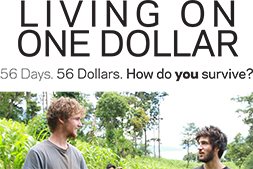
Living on One Dollar
Questions to consider as you view the film:
1. “… in analyzing social justice, there is a strong case for judging individual advantage in terms of the capability that a person has, that is, the substantive freedom he or she enjoys to lead the kind of life he or she has reason to value. In this perspective, poverty must be seen as the deprivation of basic capabilities rather than merely as lowness of incomes, which is the standard criterion of identification of poverty.”
Amartya Sen: Development as Freedom, Random House, New York, 1999. p. 88.
What is poverty? How does poverty in the United States compare to poverty in other countries?
Discuss how you saw poverty manifest in the lives of the individuals portrayed in the film, using both descriptors: lack of capabilities and lowness of income.
2. There can be no progress towards the complete development of individuals without the simultaneous development of all humanity in the spirit of solidarity.
(Populorum Progressio/On the Development of Peoples : #43 Pope Paul VI 1967)
Need-based development focuses on helping people secure immediate needs like food, clothing and shelter. Asset-based development tries to help people gain the skills, education and resources to bring themselves out of poverty.
Discuss the scenes in the film that depict situations where each type of development may be appropriate.
What role do language and intercultural competence (ability to enter into and function well in other cultures besides one’s own), play in asset based development?
“Solidarity is not a feeling of vague compassion or shallow distress at the misfortunes of so many people, both near and far. On the contrary, it is a firm and persevering determination to commit oneself to the common good; that is to say, to the good of all and of each individual, because we are all really responsible for all.”
On Social Concern /Sollicitudo rei socialis, #38, Pope John Paul II, 1987)
What does it mean to live in solidarity with a community and from a distance?
How did the students introduce themselves to the community?
Discuss moments in the film where solidarity was evident.
Resources for further discussion and learning:
Key Quotes from Catholic Social Teaching regarding development and solidarity
Solutions must be sought on the global level by establishing a true economy of communion and sharing of goods, in both the national and international order. This is the only way to respect the dignity of persons and families, as well as the authentic cultural patrimony of peoples.
(Evangelium Vitae / The Gospel of Life #91, Pope John Paul II, 1995)
Everyone has a right to life, to bodily integrity, and the means which are suitable for the proper development of life: these are primarily food, clothing, shelter, rest, medical care and finally the necessary social services.
(Pacem in Terris /Peace on Earth, Pope John XXIII, 1963)
What kind of engagement may be appropriate to alleviate extreme poverty?
Consider this essay which discusses the value of online/social media campaigns on social issues.
cnn.com/2013/04/12/opinion/sutter-slavery-end-it-movement
Do you think that raising awareness through media makes a positive change in the world?
What other ways might one act in solidarity to alleviate extreme poverty as a student?
What are ways one might act in solidarity to alleviate extreme poverty in other phases of life?
Go deeper and learn more on campus.
International Economics Program at ND
romancelanguages.nd.edu/joint-and-allied-programs/international-economics-major
economics.nd.edu/undergraduate-program/academic-programs/majors/ie
Institute for Social Concerns
International Summer Service Learning
Ford Family Program in Human Development Studies and Solidarity at Kellogg Institute ND
Explore what domestic and international NGOs are doing to alleviate poverty.
Living on One Dollar film website
For a PDF version of this film’s resources, please email Rachel Parroquin.
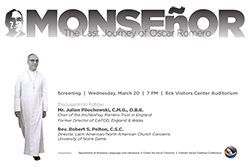
Monseñor: The Last Journey of Oscar Romero
Pacem in Terris was the last Encyclical written by Pope John XXIII before his death in 1963. The topic of it is peace, focusing the Catholic approach to peacemaking on the realization of human rights as the key component of world order.
This document was the first papal encyclical addressed to all people of good will rather than only to Catholics. It calls individuals and nations to “establish with truth, justice, charity, and liberty new methods of relationships in human society.” —Pacem in Terris, 163
The Institute for Social Concerns has used this Encyclical throughout the 2012-13 academic year to inform its programming and to highlight its continued relevance 50 years after its promulgation.
Some key quotes from Pacem in Terris of relevance to themes in the movie Monseñor are:
The attainment of the common good is the sole reason for the existence of civil authorities. In working for the common good, therefore, the authorities must obviously respect its nature, and at the same time adjust their legislation to meet the requirements of the given situation. —Pacem in Terris, 54
We must add, therefore, that it is in the nature of the common good that every single citizen has the right to share in it—although in different ways, depending on his tasks, merits and circumstances. Hence every civil authority must strive to promote the common good in the interest of all, without favoring any individual citizen or category of citizen … Nevertheless, considerations of justice and equity can at times demand that those in power pay more attention to the weaker members of society, since these are at a disadvantage when it comes to defending their own rights and asserting their legitimate interests. —Pacem in Terris, 56
Questions to consider as you view the film:
What role did the spoken word play in the ministry of Monseñor Romero? Why was that relevant to his audience in El Salvador at the time?
How did Oscar Romero’s preaching as archbishop mark a change in understanding the role of the Church in society and its relationship to the government?
How did Monseñor Romero’s last homily promote peace and nonviolence?
What themes or events in the movie do you connect to the quotes listed from the Pacem in Terris Encyclical?
For a PDF version of this film’s resources, please email Rachel Parroquin.
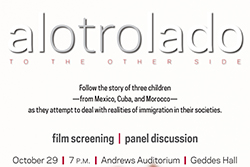
Al 0tro Lado
And among man’s personal rights we must include his right to enter a country in which he hopes to be able to provide more fittingly for himself and his dependents. It is therefore the duty of State officials to accept such immigrants and—so far as the good of their own community, rightly understood, permits—to further the aims of those who may wish to become members of a new society. —Pacem in Terris, 106
Get involved and learn more on campus: Raising Voices, Taking Action
Center for the Study of Languages and Culture (CSLC)
The CSLC is a sponsor and volunteer recruiter for the St. Joseph Chapter of the American Red Cross Community Language Bank project. The Community Language Bank provides assimilation programs and foreign language translation and interpretation services to refugees in the South Bend area. stjoe-redcross.org/refugee-services
Courses
CRN 26174 Social Concerns Seminar—Border Issues
CRN 25458 Social Concerns Seminar—Migrant Experience
CRN 2238 International Migration: Mexico/US II
CRN 25069 Immigrant Families and Mental Health
CRN 25457 ROSP 40876 Race and Ethnicity in the U.S.
CRN 29312 ROSP 20810 CBL: Language, Culture and Community
CRN 25012 ROFR 37500: Contemporary Issues w/ Catherine Perry
Also look for Summer Service Learning Program sites serving immigrant communities in the U.S.
Community Alliance to Serve Hispanics (CASH)
Serves as a liason between Notre Dame, Saint Mary’s, and Holy Cross students, faculty and staff volunteers, and social service organizations in the South Bend Hispanic community. cash@nd.edu | nd.edu/~cash
Human Rights Notre Dame
Promote the Universal Declaration of Human Rights peace@nd.edu | nd.edu/~peace
South Bend Community Partners
Catholic Charities | Contact: Claire Coleman (574) 234-3111
La Casa De Amistad | Contact: Rebecca Ruvalcaba (574) 233-2120
SBCSC Bilingual Service Department | Contact: Bill Barna (574) 283-8149
St. Adalbert Parish | Contact: Andrew Currier (574) 288-6645
St. Joseph County Chapter, American Red Cross Refugee Services Department Anton Murra
Websites for more information
United States Conference of Catholic Bishops on Immigration
Advocacy Center: Justice for Immigrants
U.S. Department of State: Office to Monitor and Combat Trafficking in Persons
Council of Europe Migration Coordination Bureau
International Organization for Migration
Questions to consider as you view the film:
What are the three stories?
How do they compare / contrast? (What do we see, hear, learn?)
How does Pacem in Terris help us frame our viewing of the film? (How do we analyze what we learn?)
What is our response to the “the immigration issue,” especially given the election season we are in? (What do we do?)
For a PDF version of this film’s resources, please email Rachel Parroquin.
